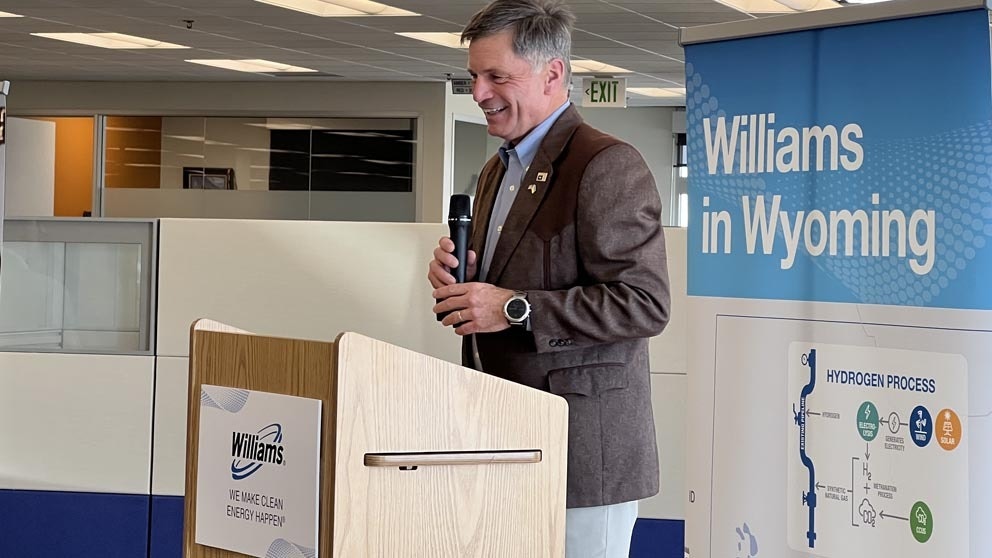WAMSUTTER — Hydrogen is getting some attention in Wyoming.
A new initiative by Williams, an energy company that handles about a third of the natural gas in America, is researching into producing hydrogen production as a clean energy source, and it’s using its existing infrastructure in Wamsutter in Sweetwater County for this research.
A delegation of legislators, local representatives, and representatives from the University of Wyoming’s School of Energy Resources (SER) met in Wamsutter to hear Governor Mark Gordon speak on Williams’ initiative.
“Wamsutter is ground zero for the future of this country and the future of energy,” Gordon said.
Additionally, Williams plans to invest $300 million over the next two years in its operations in Sweetwater County, Zamarin said.
“We’re bringing development back,” said Chad Zamarin, senior vice-president of corporate strategic development.
Zamarin said Wyoming is highly important to the company’s operations.
“We think of Wyoming as the beating heart of our energy infrastructure,” Zamarin said, adding that the company’s infrastructure stretched across the United States.


Williams is partnering with the SER to pursue research into hydrogen development, which is supported by matching funds from the state, future grants from the U.S. Department of Energy, as well as direct support from the company.
The company has around 5,000 miles of pipelines in Wyoming and over 30,000 nationwide, as well as other natural gas infrastructure, which will be used to produce and transport hydrogen products.
Unlike natural gas, hydrogen is not a source of energy, but rather a carrier of energy. It’s highly reactive, and when it comes into contact with oxygen, it produces water and energy. This is what makes it attractive as a fuel for transportation. A car running on hydrogen would produce clean, drinkable water and no CO2.
There’s various ways to make hydrogen, all of which require a large amount of energy. Various colors are assigned to the different ways it can be produced. Zamarin explained that Williams will be looking into making hydrogen from natural gas, which is called blue hydrogen. That process produces CO2 as a byproduct, which is then sequestered underground.
To illustrate his thoughts on energy policy, Gordon spoke of how when he was growing up, a neighbor purchased an International Harvester Scout, an early type of SUV. It was the first time the neighbor had any vehicle.
The neighbor drove the vehicle down a hill, but didn’t know about using the brake pedal to stop. Instead, he pulled on the steering wheel, just as one would pull back on the reins of a horse. As his speed picked up, he ended up pulling the steering wheel off.
“That’s a little bit the way our energy posture as a nation is at this point. There are some things that we’re doing that we don’t really understand, but we can solve,” the governor said.
To further illustrate the point of learning and developing technologies, Gordon recounted attempts by Hamilton Standard and Boeing to put up wind turbines in the 1980s.
“And they never ran very well, because they threw blades. Nobody understood what the challenges of Wyoming wind were,” Gordon said.
Gordon said that producing electricity from renewables will be part of the equation to the future of energy, and hydrogen, utilizing existing technologies and infrastructure, will be a significant energy source for transportation.
“How to run this country with clean hydrogen. That is something we’ve talked about for over 20 years, and never gotten as close as we are today,” Gordon said.


Another way to produce hydrogen is separating hydrogen in water molecules from oxygen, through a process of electrolysis. But Gordon stressed that Wyoming’s water would not be used for hydrogen production.
“We’re not going to burn water for transportation,” Gordon said.
Zamarin said about 2 billion people across the world still use coal, wood, and dung for cooking and basic heating.
“Two billion people still need access to cleaner energy, more reliable energy, more affordable energy. And so we are focused on meeting that need,” Zamarin said.
Williams COO Micheal Dunn said one of the characteristics of Wyoming is that its energy sector is so well supported by the state, and there’s a lot of collaboration between partners when it comes to innovation, such as Williams’ collaboration with the SER.





